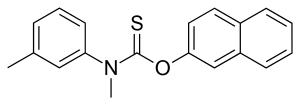Tolnaftate
 | |
| Names | |
|---|---|
| Trade names | Tinactin, Absorbine, others |
| Other names | 2-Naphthyl N-methyl-N-(3-tolyl)thionocarbamate[1] |
IUPAC name
| |
| Clinical data | |
| Drug class | Thiocarbamate[2] |
| Main uses | Jock itch, athlete's foot, ringworm, pityriasis versicolor[2] |
| Side effects | Skin irritation[2] |
| WHO AWaRe | UnlinkedWikibase error: ⧼unlinkedwikibase-error-statements-entity-not-set⧽ |
| External links | |
| AHFS/Drugs.com | Monograph |
| MedlinePlus | a682617 |
| Legal | |
| Legal status |
|
| Chemical and physical data | |
| Formula | C19H17NOS |
| Molar mass | 307.41 g·mol−1 |
| 3D model (JSmol) | |
| Melting point | 110 to 111.5 °C (230.0 to 232.7 °F) |
SMILES
| |
InChI
| |
Tolnaftate, sold under various brand names, is a medication used to treat fungal infections including jock itch, athlete's foot, ringworm, and pityriasis versicolor.[2] It is applied to the skin.[2] It comes in cream, powder, spray and solution forms.[2]
Common side effects include skin irritation.[2] It is a thiocarbamate.[2]
Tolnaftate was developed around 1962.[3] It is available as a generic medication and over the counter.[2][4] In the United States a 28 gram tube of medication costs about 6 USD as of 2021.[4] It is also available in the United Kingdom without a prescription.[5]
Medical uses
Since the availability of more potent antifungals such as terbinafine and naftifine, its use has declined.[6] Tolnaftate as a powder can be used on the feet to prevent athlete's foot in those susceptible.[7] It is useful when dealing with ringworm, especially when passed from pets to humans.[8] It has also been used to treat otitis externa due to Aspergillus app., but its poor penetration into nail has not allowed it to be of use in fungal infections of the nail.[6]
Mechanism
Although the exact mechanism of action is not entirely known, it is believed to inhibit squalene epoxidase,[9] an important enzyme in the biosynthetic pathway of ergosterol (a key component of the fungal cell membrane) in a similar way to terbinafine.[10]
See also
- Liranaftate, a similar thiocarbamate antifungal
References
- ↑ "International Non-Proprietary Names for Pharmaceutical Preparations. Recommended International Non-Proprietary names (Rec. I.N.N.): List 6" (PDF). World Health Organization. Archived (PDF) from the original on 10 August 2020. Retrieved 12 November 2016.
- 1 2 3 4 5 6 7 8 9 "Tolnaftate Monograph for Professionals". Drugs.com. Archived from the original on 28 January 2021. Retrieved 6 October 2021.
- ↑ Greenwood, David (21 February 2008). Antimicrobial Drugs: Chronicle of a Twentieth Century Medical Triumph. OUP Oxford. p. 360. ISBN 978-0-19-953484-5. Archived from the original on 9 October 2021. Retrieved 6 October 2021.
- 1 2 "Compare Tolnaftate Prices - GoodRx". GoodRx. Retrieved 6 October 2021.
- ↑ BNF (80 ed.). BMJ Group and the Pharmaceutical Press. September 2020 – March 2021. p. 1294. ISBN 978-0-85711-369-6.
{{cite book}}: CS1 maint: date format (link) - 1 2 Ghannoum, Mahmoud; Isham, Nancy (2017). "Tolnaftate". Kucers’ The Use of Antibiotics (7 ed.). CRC Press. ISBN 978-1-315-15211-0. Archived from the original on 2021-10-09. Retrieved 2021-10-07.
- ↑ James, William D.; Elston, Dirk; Treat, James R.; Rosenbach, Misha A.; Neuhaus, Isaac (2020). "15. Diseases resulting from fungi and yeasts". Andrews' Diseases of the Skin: Clinical Dermatology (13th ed.). Elsevier. pp. 297–299. ISBN 978-0-323-54753-6. Archived from the original on 2021-10-03. Retrieved 2021-10-04.
- ↑ Crawford F, Hart R, Bell-Syer S, Torgerson D, Young P, Russell I. Topical treatments for fungal infections of the skin and nails of the foot (Cochrane Review). In: The Cochrane Library, Issue 1, 2003. Oxford: Update Software.
- ↑ Ryder NS, Frank I, Dupont MC (May 1986). "Ergosterol biosynthesis inhibition by the thiocarbamate antifungal agents tolnaftate and tolciclate". Antimicrob. Agents Chemother. 29 (5): 858–60. doi:10.1128/aac.29.5.858. PMC 284167. PMID 3524433.
- ↑ "antifung". Archived from the original on 2008-06-17. Retrieved 2008-07-09.
External links
| Identifiers: |
|---|
- Medline's entry for tolnaftate Archived 2016-07-05 at the Wayback Machine